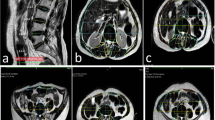Abstract
Background: The strength of abdominal muscle and back extensors or their balances are commonly mentioned as major indicators of potential low back pain (LBP). Former studies on anthropometrics in terms of trunk muscle strength seemed to lack precision in methodology. Furthermore, the extension-flexion ratio, which is a good parameter of trunk muscle balance, was not as much studied as simple maximum torques in this area of study. Objectives: To investigate relationship between trunk muscle strength and lumbar lordosis, sacral angle in patients who did not show significant abnormal findings on their simple lateral radiograph. Methods: Thirty-one subjects were participated and their mean age was 35. Lumbar simple lateral radiograph was taken and lordotic angle was obtained by altered Cobb’s method. Sacral angle was also examined on the same film. The relationship between these angles and muscle strength (isometric maximum torques and ratios of them) was investigated by the correlation analysis. Results: None of the isometric maximum torques was related to sacral angle or lordotic angle. However, the ratio of extension to flexion was significantly related to the lordotic angle (Pearson’s correlation coefficient=0.491, p<0.01). Other ratios were not related to any of the angles. Conclusions: An imbalance in trunk muscle strength can influence significantly lordotic curve of lumbar spine and might be one risk factor for potential low back pain.




Similar content being viewed by others
References
Bayramoglu M, Akman MN, Kilinc S, Cetin N, Yavuz N, Ozker R (2001) Isokinetic measurement of trunk muscle strength in women with chronic low back pain. Am J Phys Med Rehabil 80(9):650–655
Beimborn DS, Morrissey MC (1988) A review of the literature related to trunk muscle performance. Spine 13(6):655–660
Gomez T, Beach G, Cooke C, Hrudey W, Goyert P (1991) Normative database for trunk range of motion, strength, velocity, and endurance with the isostation B-200 lumbar dynamometer. Spine 16(1):15–21
Heino JG, Godges JJ, Carter CL (1990) Relationship between hip extension range of motion and postural alignment. J Orthop Sports Phys Ther 12:243–247
Kendall FP, McCreary, Provance PG (1993) Muscles testing and function, 4th edn. Williams & Wilkins, Baltimore, pp 133–134
Lee JH, Yuichi Hoshino, Kozo Nakamura, Yusei Kariya, Kazuo Saita, Kuniomi Ito (1999) Trunk muscle weakness as a risk factor for low back pain. Spine 24(1):54–57
Morton RF, Hebel JR (1989) A study guide to Epidemiology and Biostastics, 3rd edn. Aspen Publication, Gaithersburg, MD, p 94
Na YM, Kang SW, Bae HS, Kang MJ, Park JS, Moon JH (1996). The analysis of spinal curvature in low back pain patients. J Korean Acad Rehab Med 20(3):669–674
Newton M, Waddell G (1993) Trunk strength testing with iso-machines Part 1. Spine 18(7):801–811
Noh YH, Keum DH (2000) A clinical observation for the lumbosacral angle changes between initial and follow up treatment in low back pain patients. J Oriental Rehab Med 10(1):11–21
Polly DW, Kilkelly FX, McHale KA, Asplund LM (1996) Measurement of lumbar lordosis. Spine 21(13):1530–1536
Rene Cailliet (1995) Low back pain syndrome, 5th edn. F. A. Davis Company, Philadelphia, pp23–25, 100–102
Stuart M (1992) The influence of lordosis on axial trunk torque and trunk muscle myoelectric activity. Spine 17(10):1187–1193
Tsuji T, Matsuyama Y, Sato K, Hasegawa Y, Yimin Y, Iwata H (2001) Epidemiology of low back pain in the elderly: correlation with lumbar lordosis. J Orthop Sci 6(4):307–311
Walker ML, Rothstein JM. Finucane SD, Lamb RL (1987) Relationship between lumbar lordosis, pelvic tilt, and abdominal muscle performance. Phys Ther 4:512–516
Youdas JW, Garrett TR, Egan KS, Therneau TM (2000) Lumbar lordosis and pelvic inclination in adults with chronic low back pain. Phys Ther 80(3):261–275
Youdas JW, Garrett TR, Harmsen S (1996) Lumbar lordosis and pelvic inclination of asymptomatic adults. Phys Ther 76:1066–1081
Acknowledgments
This experiment complies with the current law of South Korea inclusive ethics approval. Supported by Research Fund from KyungHee University.
Author information
Authors and Affiliations
Corresponding author
Additional information
Supported by Reasearch Fund from KyungHee University
Rights and permissions
About this article
Cite this article
Kim, HJ., Chung, S., Kim, S. et al. Influences of trunk muscles on lumbar lordosis and sacral angle. Eur Spine J 15, 409–414 (2006). https://doi.org/10.1007/s00586-005-0976-5
Received:
Revised:
Accepted:
Published:
Issue Date:
DOI: https://doi.org/10.1007/s00586-005-0976-5




